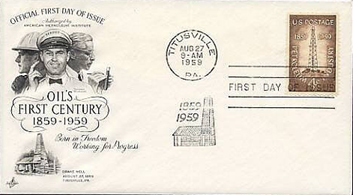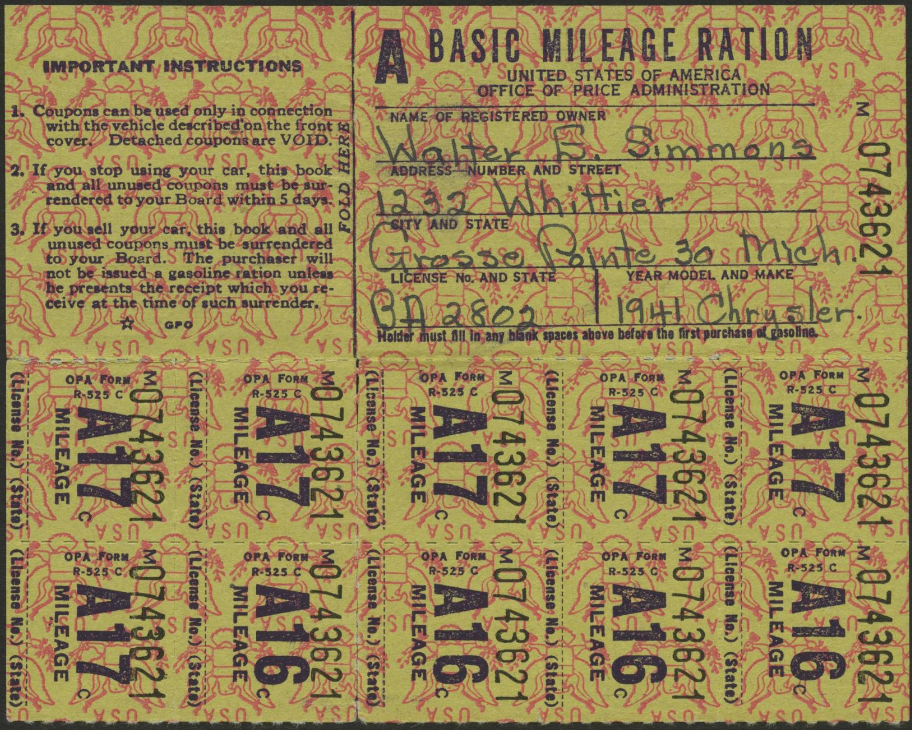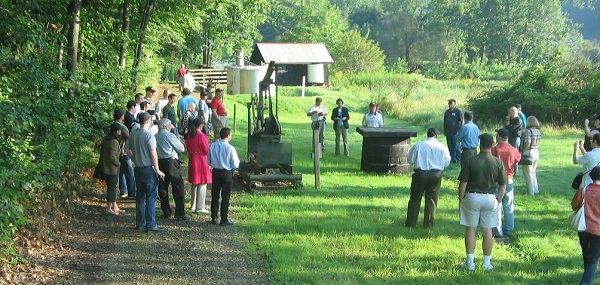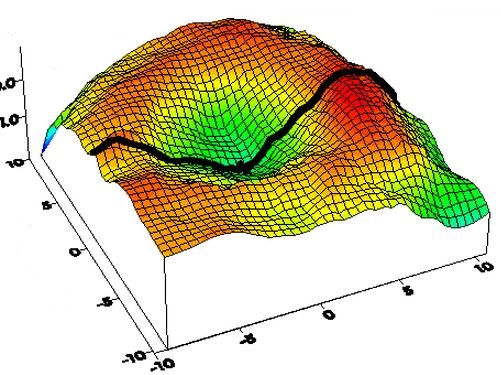August 12, 1888 – Bertha Benz makes World’s First Auto Road Trip –
Thirty-nine-year-old Bertha Benz made history when she became the first person to make a long-distance trip by automobile. Her adventure also included, “the first road repairs, the first automotive marketing stunt, the first case of a wife borrowing her husband’s car without asking, and the first violation of intercity highway laws in a motor vehicle,” noted a 2012 article in Wired.

Bertha Benz became the world’s first female automotive pioneer in 1888. Image courtesy Mercedes-Benz Museum.
Bertha drove away in the “Patent Motorwagen” (after leaving a note to her husband) and took their two young sons to visit her mother in Pforzheim. Their route from Mannheim was about 60 miles. The drive, which took about 15 hours, helped popularize Karl Benz’s latest invention.
By the end of the century, Mercedes-Benz was the largest car company in the world. The first road trip can today be retraced by following signs of the Bertha Benz Memorial Route. She was inducted into the Automotive Hall of Fame in 2016 as the first female automotive pioneer.
Learn more in First Car, First Road Trip.
August 12, 1930 – Kentucky Oil and Gas Producers unite
Eastern Kentucky independent producers joined the Western Kentucky Oil Men’s Association to create a state-wide organization in Frankfort — today’s Kentucky Oil and Gas Association (KOGA). A 1919 oil discovery in Hancock County had launched the petroleum industry in western Kentucky, where commercial amounts of oil had been found as early as 1829 near Burkesville while drilling for brine with a spring-pole (also see Kentucky’s Great American Well).
August 13, 1962 – Norman Rockwell illustrates Oil and Gas Journal
The Oil and Gas Journal promoted itself with an illustration from artist Norman Rockwell in an ad captioned, “Where Oil Men Invest Their Valuable Reading Time.” Rockwell’s renditions of American life brought him popularity through magazines like the Saturday Evening Post, Boy’s Life, and Leslie’s Illustrated Weekly.

A Norman Rockwell illustration advertised a leading industry trade magazine.
In addition to the illustrations for the Oil and Gas Journal, in 1959 Rockwell provided artwork to the American Petroleum Institute (API), which sponsored a U.S. Postal Service “first day of issue” commemorating the 1959 centennial of the birth of the U.S. oil industry (see Centennial Oil Stamp Issue).
The illustration included the slogan “Oil’s First Century 1859-1959, Born in Freedom Working for Progress.”

Norman Rockwell’s art commemorated the 1959 centennial of the birth of the nation’s oil industry.
Rockwell’s drawing depicted “the men of science, the rugged extraction of the crude oil, and ending with your friendly service station attendant,” according to a collector.
Learn about another petroleum-related illustrator in Seuss I am, an Oilman.
August 14, 1986 – California Oil Museum Building listed as National Historic Place
The original headquarters of the Union Oil Company in Santa Paula, California — constructed in 1890 and an oil museum since 1950 — was added to the National Register of Historic Places. Today, the California Oil Museum on 1001 East Main Street includes renovated Union Oil offices on the second floor, above the former Santa Paula Hardware Company and Post Office. Union Oil moved its headquarters to Los Angeles in 1901.

The Union Oil Company headquarters building, built in 1890, is home of the California Oil Museum.
Also designated a Ventura County Cultural Heritage Landmark, the California Oil Museum exhibits working oilfield models, a 19th century cable-tool drilling rig, Union Oil gas station memorabilia, and an Energy Education Lab with STEM activities for students.
August 15, 1945 – End of World War II Gas Rationing
One day after President Harry Truman announced World War II was over, gasoline rationing ended in America. Food rationing had begun in early 1942 with rubber and gasoline added in December by the Office of Price Administration. Most civilian drivers received a windshield sticker with ration coupons for gasoline limiting them to four gallons a week. A ration book “B” sticker allowed business owners up to eight gallons a week.

World War II gasoline ration stamps and mileage card, Grosse Pointe, Michigan. Image courtesy Henry Ford Museum.
According to the National World War Two Museum, a “C” sticker was for people with professional occupations, an “M” sticker for motorcycles, and a “T” sticker for truck drivers. A 35 mph speed limit was established for the duration of the war. By the end of 1945, sugar remained the only commodity still being rationed.
August 16, 1861 – Oldest Producing Well drilled in Pennsylvania
What would become the world’s oldest continuously producing oil well was completed near Oil Creek at Oil City, Pennsylvania. The McClintock No. 1 well initially produced 50 barrels of oil a day from a depth of 620 feet. The well was completed 14 miles from Titusville, home of the first U.S. commercial oil discovery two years earlier.
The McClintock well is the oldest well in the world that is still producing oil at its original depth, according to the Oil Region Alliance.

Drilled in 1861, the McClintock well is pumped a few times a year to supply oil for souvenir bottles sold at the Drake Well Museum and Park in Titusville, Pennsylvania. Photo by Bruce Wells.
Donated by Quaker State in 1995, the well has been pumped monthly to produce up to 10 barrels of oil. A nearby historic marker identifies the well, but thousands of people pass by each year without knowing it’s there. Souvenir bottles of the oil are on sale in the gift shop of the Drake Well Museum in Titusville.
August 16, 1927 – High-Octane Gas powers Air Race to Hawaii
With a crowd of 50,000 cheering them on, eight monoplanes took off from an airfield in Oakland, California, in an air race over the Pacific. Dole Pineapple Company offered a $25,000 prize to the first plane to reach Honolulu, 2,400 miles away. Three months earlier, Charles Lindbergh had made the first solo trans-Atlantic flight of 1,500-miles.

Several competitors disappeared over the Pacific during the 1927 Dole air race. The winning aircraft today is on display at the Woolaroc Ranch near Bartlesville, Oklahoma.
A new aviation fuel developed by Phillips Petroleum — Nu-Aviation Gasoline — powered the winning “Woolaroc” monoplane for the deadly air race (two of the fuel-heavy planes crashed on takeoff, others were lost in flight). Woolaroc was named for Frank Phillips’ Bartlesville ranch and nature preserve.
Learn more in Flight of the Woolaroc.
August 17, 1785 – Oil Discovered Floating on Pennsylvania Creek
Two years after the end of the Revolutionary War, oil was reported floating on a creek in northwestern Pennsylvania. “Oil Creek has taken its name from an oil or bituminous matter being found floating on its surface,” noted a report by Gen. William Irvine.
“Many cures are attributed to this oil by the natives, and lately by some of the whites, particularly rheumatic pains and old ulcers,” Gen. Irvine wrote. He confirmed an earlier Army survey reporting Oil Creek, “empties itself into the Allegheny River, issuing from a spring, on the top of which floats an oil, similar to what is called Barbados Tar, and from which may be collected by one man several gallons in a day.”
August 17, 1915 – End of Hand-Cranked Auto Engines
Charles Kettering of Dayton, Ohio, patented an “engine-starting device,” the first practical electric starter for automobiles. Working as an engineer for Dayton Engineering Laboratories Company (DELCO), Kettering earlier had devised an electric motor to replace hand cranks on cash registers.
“The present invention is particularly applicable to automobiles, wherein an engine of the combustion or explosion type is employed, as a means of propulsion,” Kettering noted in his patent. Cadillac was the first manufacturer to add electric starters to its models; the Ford Model T used a hand crank until 1919.
In addition to his engine-starting patent, in 1921 Kettering and fellow General Motors chemist Thomas Midgely Jr. discovered the gasoline additive tetraethyl lead (see Ethyl Anti-Knock Gas).
August 18, 1990 – Oil Pollution Act becomes Law
President George H.W. Bush signed the Oil Pollution Act of 1990, which was passed by the 101st Congress to strengthen the ability of the Environmental Protection Agency (EPA) to prevent and respond to catastrophic oil spills. Signed into law 17 months after the Exxon Valdez oil spill in Prince William Sound, Alaska, the act required vessels and oil storage facilities to submit to the federal government plans detailing how they would respond to large spills.
August 18, 2007 – Astrobleme Museum opens in Oklahoma
Ames, Oklahoma, celebrated the opening of its Astrobleme (meteor crater) Museum, designed to educate visitors about a meteor impact that led to a major oilfield discovery 450 million years later. Located about 20 miles southwest of Enid, the Ames meteor crater was buried by about 9,000 feet of sediment, making it barely visible on the surface. Most geologists believed impact craters unlikely locations for petroleum.

A meteorite hit Oklahoma 450 million years ago, producing a crater thousands of feet deep and eight miles wide. It proved to be one of six oil-producing U.S. impact craters.
Although wells were drilled nearby, no one had attempted to reach deep into the hidden, eight-mile-wide Ames crater in Major County. In 1991, Continental Resources CEO Harold Hamm decided to drill to a depth of about 10,000 feet, deeper than usual for the area, and found an oilfield. His Ames crater discovery well uncovered what became the most prolific of the six oil-producing craters found in the United States.

Oklahoma’s Ames Astrobleme Museum, which opened in 2007, requires no staff to educate visitors. Photo by Bruce Wells.
“The Ames Astrobleme is one of the most remarkable and studied geological features in the world because of its economic significance,” explained independent producer Lew Ward in 2007. The potential of drilling in impact craters got the attention of oil companies worldwide.
Learn more in Ames Astrobleme Museum.
_______________________
Recommended Reading: Bertha Takes a Drive: How the Benz Automobile Changed the World (2017); Western Pennsylvania’s Oil Heritage
(2008); Winners’ Viewpoints: The Great 1927 Trans-Pacific Dole Race
(2009); Glory Gamblers
(1961); Groundbreakers: The Story of Oilfield Technology and the People Who Made it Happen (2015); Standard Oil Company: The Rise and Fall of America’s Most Famous Monopoly
(2016); Oil And Gas In Oklahoma: Petroleum Geology In Oklahoma
(2013). Your Amazon purchase benefits the American Oil & Gas Historical Society. As an Amazon Associate, AOGHS earns a commission from qualifying purchases.
_______________________
The American Oil & Gas Historical Society (AOGHS) preserves U.S. petroleum history. Please become an AOGHS annual supporter and help maintain this energy education website and expand historical research. For more information, contact bawells@aoghs.org. © 2024 Bruce A. Wells. All rights reserved.



